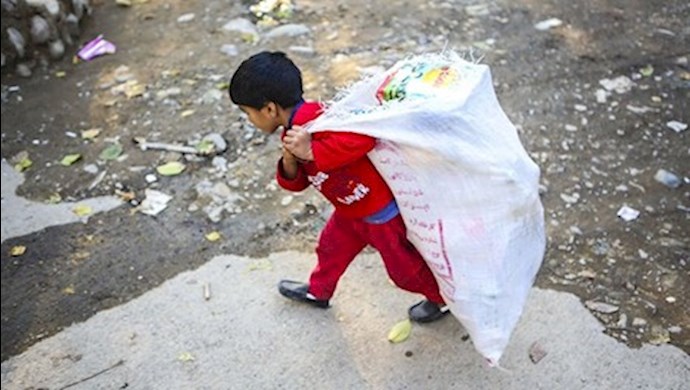Reporting by PMOI/MEK
Iran, November 8, 2020—Iran is seeing a steep increase in child labor. While unemployment is rampant across the country, more children are joining Iran’s workforce, roaming the streets of large cities, begging, or selling goods. Many of these children are exposed to physical and sexual abuse from the traffickers, and are sometimes forced into drug addiction.
Mohammad Moshefi, Deputy Mayor of the city of Mashhad, northeast Iran, said in an interview with the Tasnim news agency, an outlet linked to the regime’s Revolutionary Guards (IRGC) Quds Force: “Due to the economic situation and the Covid-19 outbreak, the number of child laborers in streets has increased significantly,”
“Some of these children work under the supervision of profiteers and traffickers,” he added.
4,600 garbage collector children in Tehran

Child labor in Iran
“Last year in July, an NGO conducted a survey to identify all garbage collector children and announced accurate statistics in this regard. 4,600 garbage collector children were identified in Tehran according to this survey,” Mahmoud Abbasi, the regime’s deputy minister of justice for human rights, said in an interview with regime’s official ILNA news agency on November 1.
Referring to the abuse of these children by the looting gangs of the regime in collecting garbage in Tehran Municipality, the government official added: “Those who exploit the children are contractors who are working with the Tehran municipality. Therefore, in correspondence with the municipality, we demanded that it ends its cooperation with these contractors.”
This regime official seeks to punish the contractors without mentioning the causes of this catastrophe and the definitive solution.
“In many cases children simply disappear and their body parts are smuggled. Sometime later, their dead bodies turn up in deserted areas without kidneys and eyes.”#Iranhttps://t.co/Cj6OWlAPA7
— People’s Mojahedin Organization of Iran (PMOI/MEK) (@Mojahedineng) October 29, 2019
“The situation of child labor in the provinces of Sistan & Baluchestan and Razavi Khorasan is ‘catastrophic’ and the number of child labor in these provinces is very high,” Abbasi added.
Abbasi did not provide any statistics in this regard, saying that most government statistics on child labor are inaccurate.
Earlier, in June, the deputy mayor of the Tehran Municipality Mohammadreza Javadi had said: “Child labor is a complex and multi-faceted subject and because of this, many measures that have been taken over the years have not been successful, and the number of working children who are begging in the street or selling goods is increasing day by day. Child labor is caused by poverty. The families send their childred to the streets to gain some money.”
Meanwhile, Nayereh Abedinzadeh, the deputy prosecutor of Mashhad, has said that 30 children who have been “sexually abused and raped” have been supported during the implementation of a plan named “Canopy of Hope,” but did not provide details on when the children had been victimized.
Abedinzadeh also announced the arrest of five people who she said were the “leaders” of these children.
She has said that some of these leaders earn 100 million rials (about $400) a night by abusing these children, and eventually 200,000 rials (about 80 cents) will go to the child.
“Last week in Mashhad, 85 child laborers were identified, of whom 24 were Iranian and 61 were foreigners,” she added.
“Some of the children who have been identified are likely to have been sexually abused and there are signs of beatings on their bodies,” she continued.
In reality, the situation of child labor in Iran is much worse.
“Some economics say that the number of child labor in Iran is 3-7 million. This figure is estimated 20,000 for Tehran but because most of child labor do not have any identity card; the exact number in this regard cannot be provided,” said Nahid Tajadin, a member of the regime’s Majlis (parliament), on September 27, 2017.
These are homeless and poor children who have no other means to make ends meet and are being exploited by regime officials to make huge financial gains.
And as the regime’s corruption continues to take its toll on the economic situation, Iranian workers can’t afford to send their children to school, and as a result these children are forced to leave their schools.





